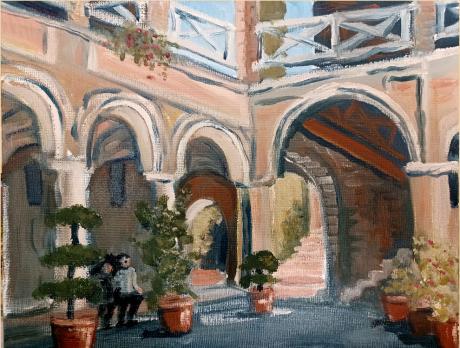" P Yates" and inscribed on the reverse
The Church of Hagios Demetrios, the earliest of the surviving churches of Mystras, is the metropolitan church built in the second half of the 13th century as a wooden-roofed basilica.
The metropolitan was erected by the metropolitan Eugenios (1262–72), who is depicted in the diakonikon, where his tomb was also discovered. To his successor Theodosios (1272–83?) are due a large portion of the wall paintings decorating the church. Theodosios, who subscribed to a policy of reconciliation with the papacy as promoted by Emperor Michael VIII Palaiologos, was represented kneeling in prayer at the feet of the Virgin in the conch of the sanctuary apse. However, his image was intentionally scraped off in an act of damnatio memoriae by one of his successors, probably Nikephoros Moschopoulos (1288?–1315), who was a follower of Andronikos II’s policy against reconciliation. In the inscriptions he had carved in the church Moschopoulos promoted himself as the church’s founder. During his tenure the Metropolis flourished. It had a library and most likely a scriptorium for copying manuscripts. He himself completed the painted decoration of the church, with, among others, figures of the apostles in the south aisle in the heavy or cubist manner of the end of the thirteenth century.
Around 1310 he decorated the narthex with scenes of the Second Coming and of the Ecumenical Councils, among other works. These wall paintings follow a stylistic trend in which the human form is represented with three-dimensionality but without exaggeration, a trend visible in some of the most outstanding monuments of Constantinople from the decade 1310–20, such as the paintings in the chapel of the Pammakaristos Monastery and in the Chora Monastery.
In the first half of the fifteenth century galleries were added to the Metropolis, which thus took on the form of the Mystras type of church. According to a relief inscription, this conversion was achieved under the metropolitan Matthew. In the older literature the conversion was associated with the supposed coronation of Constantine Palaiologos in the Metropolis in 1448/49, a hypothesis that does not appear to be supported by the sources. The exterior wall paintings of the north portico, depicting four deceased metropolitans of the fourteenth and early fifteenth centuries, have also been associated with the changes brought about by Matthew in the fifteenth century. Abbreviations of his name also appear on the imposts of the proskynetaria of the templon, while the rest of the marble sculptural elements of the templon date to around 1200 and were reused, having originally come from an unknown church of the southern Peloponnese.

